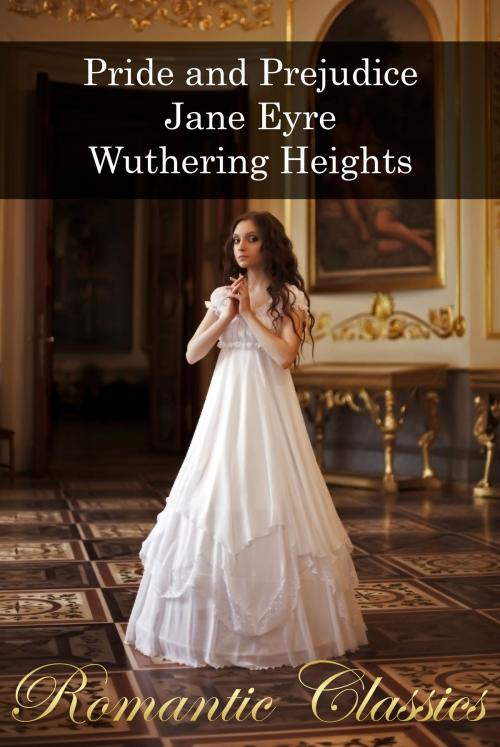Romantic Classics: Pride and Prejudice, Jane Eyre, Wuthering Heights
Fiction & Literature, Classics, Romance| Author: | Jane Austen, Charlotte Brontë, Emily Brontë | ISBN: | 1230000151069 |
| Publisher: | WriterMotive | Publication: | July 12, 2013 |
| Imprint: | Language: | English |
| Author: | Jane Austen, Charlotte Brontë, Emily Brontë |
| ISBN: | 1230000151069 |
| Publisher: | WriterMotive |
| Publication: | July 12, 2013 |
| Imprint: | |
| Language: | English |
Three classics of English literature in one single volume.
Pride and Prejudice: The novel centers on Elizabeth Bennet, the second of the five daughters of a country gentleman. Jane Bennet, the eldest daughter, is distinguished by the kindness of her attitudes; Elizabeth Bennet, the second daughter, shares her father's keen wit and occasionally sarcastic outlook; Mary is studious, devout and aspires to be musical; Kitty, the fourth sister follows where her youngest sister leads, while Lydia is flirtatious and unrestrained.
Mr Darcy is the male protagonist of the novel. Twenty-eight years old and unmarried, Mr Darcy is also the wealthy owner of the famous family estate of Pemberley in Derbyshire. He makes a poor impression on strangers, such as the landed gentry of Meryton, but is valued by those who know him well. Throughout the progression of the plot, Darcy and Elizabeth are forced to be in each other's company, causing each character to see the other in a different light.
Jane Eyre: follows the emotions and experiences of its eponymous character, including her growth to adulthood, and her love for Mr. Rochester, the byronic master of Thornfield Hall. The focus is on the gradual unfolding of Jane's moral and spiritual sensibility and all the events are colored by a heightened intensity that was previously the domain of poetry — the novel revolutionized the art of fiction.
Wuthering Heights: The book's core theme is the destructive effect that jealousy and vengefulness have, both on the jealous or vengeful individuals and on their communities.
Although Wuthering Heights is now widely regarded as a classic of English literature, it received mixed reviews when first published, and was considered controversial because its depiction of mental and physical cruelty was so unusually stark.In the second half of the 19th century, Charlotte Brontë's Jane Eyre was considered the best of the Brontë sisters' works, but later critics argued that Wuthering Heights was superior.
Three classics of English literature in one single volume.
Pride and Prejudice: The novel centers on Elizabeth Bennet, the second of the five daughters of a country gentleman. Jane Bennet, the eldest daughter, is distinguished by the kindness of her attitudes; Elizabeth Bennet, the second daughter, shares her father's keen wit and occasionally sarcastic outlook; Mary is studious, devout and aspires to be musical; Kitty, the fourth sister follows where her youngest sister leads, while Lydia is flirtatious and unrestrained.
Mr Darcy is the male protagonist of the novel. Twenty-eight years old and unmarried, Mr Darcy is also the wealthy owner of the famous family estate of Pemberley in Derbyshire. He makes a poor impression on strangers, such as the landed gentry of Meryton, but is valued by those who know him well. Throughout the progression of the plot, Darcy and Elizabeth are forced to be in each other's company, causing each character to see the other in a different light.
Jane Eyre: follows the emotions and experiences of its eponymous character, including her growth to adulthood, and her love for Mr. Rochester, the byronic master of Thornfield Hall. The focus is on the gradual unfolding of Jane's moral and spiritual sensibility and all the events are colored by a heightened intensity that was previously the domain of poetry — the novel revolutionized the art of fiction.
Wuthering Heights: The book's core theme is the destructive effect that jealousy and vengefulness have, both on the jealous or vengeful individuals and on their communities.
Although Wuthering Heights is now widely regarded as a classic of English literature, it received mixed reviews when first published, and was considered controversial because its depiction of mental and physical cruelty was so unusually stark.In the second half of the 19th century, Charlotte Brontë's Jane Eyre was considered the best of the Brontë sisters' works, but later critics argued that Wuthering Heights was superior.















